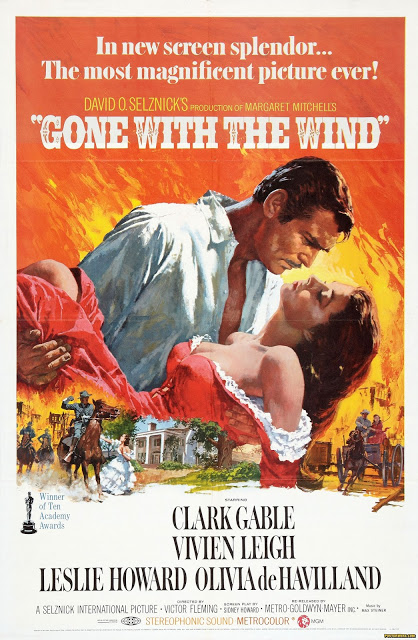Set in a romanticized version of the Antebellum South, the film shows the Civil War from the perspective of the plantation owners. The film opens with Scarlett O'Hara as a coquettish and captivating young woman, flirting with boys while in love with a married man. As the war progresses, the old chivalry seemingly characteristic of that era is stripped away to reveal a way of life that is crumbling before the Confederacy's eyes. During the course of the movie, Scarlett encounters and marries several other men as they serve her purposes, eventually, becoming involved with Rhett Butler (Clark Gable in his best remembered performance.) But while her purposes aren't always noble or even kind, Scarlett is, above all else, a survivor who will get what she wants, whether she must make clothes out curtains to do it, or traverse a burning city! Whether Scarlett was always scheming, or whether the famine and poverty that accompanied the fall of the South made her that way is a central theme of the movie, as it questions what drive without kindness is, and pits chivalry against truthfulness.
Entire books and films can- and have- been made to tell the story behind Gone With the Wind. A break-away, best seller novel in the thirties, David O. Selznik bought the movie rights for his attempt to make the Ultimate Movie. His fingerprints are on everything- in part because he micromanaged everything and everyone. When casting, he secured Clark Gable on loan from his father-in-law, MGM head exec Louie B Mayer, in exchange for MGM gaining distribution rights. As the undisputed King of Hollywood, Gable really seemed the only man for the job. Far harder was finding the right woman for Scarlett. Nearly every Hollywood actress lobbied for the part and nearly as many did screen-tests (Katherine Hepburn famously recalls being told "I can't see Rhett Butler chasing you for twelve years" when turned down for the part). Huge, country wide searches were held to find the perfect fit for Scarlet O'Hara. Vivian Leigh, an actress little known to American audiences, was quietly introduced to Selznick at the eleventh hour-filming had already started- and she ultimately won the role. It was a part that would make Leigh's name, but ultimately would be an unhappy period in her life, as she was ordered to keep her relationship with famous Shakespearian thespian Sir Laurence Olivier under wraps. Multiple directors were brought in to take the helm of this mammoth project. First was famous "woman's director" George Cukor. He was quickly replaced by Victor Fleming at Gable's request, because he want a director more focussed on the men. Fleming was Gable's big game hunting buddy who would take on the lion's share of work on the film, although Leigh, feeling desperate and slighted, continued to seek out Cukor's guidance on the sly. A third director was brought in for a time as Flemming had to recover from exhaustion. The effort put into the movie was intense for all involved, but the sheer scale- its epic nature- comes shining through in scenes such as the burning of Atlanta (in which they burned many of MGM Studio's largest set pieces, including the famous Pillars of Hercules) and the scene of wounded soldiers (most of whom were actually life-sized puppets).
The movie's also epic in terms of length, coming in at almost 4 hours long, and including both an overture and an intermission. When first shown to test audiences, it spanned an even longer length- 5 hours! In a year packed with some of the most memorable Hollywood films of all time (1939 also saw the release of The Wizard of Oz, Stagecoach, and Mr. Smith Goes to Washington, among others), Gone with the Wind took home a record-setting 8 awards, including one for best picture, and a Best Director for Victor Fleming. Perhaps most notable though, was the fact that Best Supporting Actress went to Hattie McDaniel. Her portrayal of Mamie placed her in the history books as the first African American actor to be given an Academy Award. Despite this, she was segregated from her co-stars at the ceremony, and was outright barred from coming to the movie's opening in Atlanta, where Jim Crow laws were still in place.
Though some race barriers were broken by McDaniel, Gone with the Wind is not without its flaws and most significant among them is how black characters are marginalized and infantilized within the story. They are shown, almost without exception, as happy and content in their situation as slaves, and unhappy to be freed. While Gone with the Wind never goes to the Ku Klux Klan-idolizing levels that film Birth of a Nation, infamously goes to, it does paint a romanticized picture of the Old South in a way that never existed in reality.
The other few downsides to the film include the fact that its not overly sympathetic to the main character, and the film is far too long to watch regularly. It is also the rare film that perhaps would have benefitted had the producer not been so faithful to the book. Not to ruin the surprise for anyone who hasn't seen this, but- famous last lines not withstanding- the ending seems very unsure and random, as if the author just got bored of rewrites. The film would have been just as strong- or stronger- it had ended twenty minutes earlier.
Still, if for no other reason than the fact that amongst those 3 hours and 53 minutes, two of the most famous lines in movie-making are uttered ("frankly, my dear..." and "God as my witness I will never go hungry again!") you must see this. It's story is filled with drama and good acting, for the most part. So watch it. Because, frankly, my dear... you will give a damn about Gone with the Wind.
Still, if for no other reason than the fact that amongst those 3 hours and 53 minutes, two of the most famous lines in movie-making are uttered ("frankly, my dear..." and "God as my witness I will never go hungry again!") you must see this. It's story is filled with drama and good acting, for the most part. So watch it. Because, frankly, my dear... you will give a damn about Gone with the Wind.





This was a very interesting read. I had no idea about all the back history on this movie. I don't even think I've watched the full film, just bits and pieces.
Reply Deletebisous
Suzanne
Its so long, I didn't realize I'd only watched parts of it till sitting down to review it. You've really got to consciously commit to the running time of this film... I mean, I enjoyed it, but man- So. Long.
DeleteThis is such a classic film!
Reply DeleteExcellent recap and commentary
Reply DeleteI remember watching this movie with my dad when I was a little girl. He told me it was a classic. At the time, we only had a few channels so I felt lucky to be able to watch something which felt so historic to me! I loved the outfits.
Reply DeleteLovely commentary on it.
<3 Amy
Thank you; and yes, it is definitely a classic!
Delete